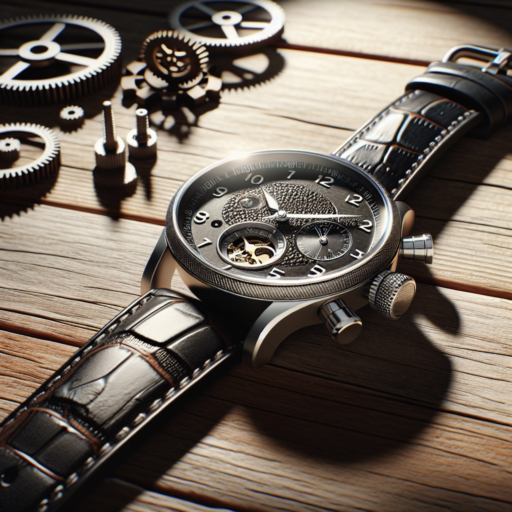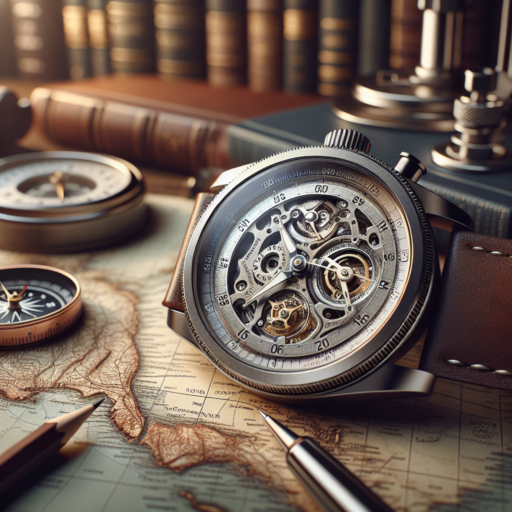Introduction to Barometer on Watches: Elevating Your Outdoor Experience
Exploring the great outdoors has always been about embracing the elements and preparing for the unpredictable. One of the most sophisticated yet often overlooked features that can significantly enhance this experience is the incorporation of a barometer in watches. A barometer, a device used for measuring atmospheric pressure, is not just a tool for meteorologists but a pivotal feature for outdoor adventurers. The inclusion of this component in wristwatches has opened a new horizon in outdoor exploration, making it an indispensable tool for hikers, climbers, and anyone involved in outdoor activities.
Understanding the functionality of a barometer in a watch begins with recognizing its ability to forecast short-term changes in the weather. Sudden drops in atmospheric pressure can signal the approach of bad weather, while a steady or rising pressure suggests fairer conditions. This real-time data allows outdoor enthusiasts to make informed decisions, whether it’s about seeking shelter before a storm hits or taking advantage of a clear day to push forward with their adventure. The integration of a barometer transforms a conventional timepiece into a personal weather station, offering not just time but also critical environmental insights.
The advent of barometer-equipped watches has made a profound impact on outdoor safety and planning. Prior to this technology, adventurers relied heavily on traditional weather forecasts, which could be imprecise for specific locales and times. Now, with the data directly on their wrist, they have immediate access to environmental changes, substantially reducing the risk of being caught off guard by adverse weather conditions. Moreover, for those engaged in activities such as mountain climbing, where altitude plays a crucial role, barometric readings can also assist in navigation and altitude estimation, further proving the versatility of this feature.
How a Barometer on Your Watch Works and Why It Matters
Understanding the functionality of a barometer integrated into your watch is an intriguing journey into both historical meteorological tools and modern technological advances. At its core, a barometer on your watch measures atmospheric pressure using sensitive electronic sensors. These sensors detect minor changes in the external pressure, allowing the device to infer possible weather changes. This capability transforms your watch from a mere timekeeping tool into a personal weather station on your wrist.
The significance of having a barometer in your watch can’t be overstated, especially for outdoor enthusiasts and professionals whose activities are weather-dependent. By constantly monitoring changes in atmospheric pressure, your watch can alert you to impending weather phenomena. A sudden drop in pressure, for example, often precedes storms, giving you enough time to seek shelter or adjust your plans. Conversely, a gradual increase in pressure might indicate improving weather conditions, ideal for outdoor activities.
How It Matters, beyond just forecasting weather, the barometer function can serve as a critical safety tool. Hikers and mountaineers, for instance, depend on accurate weather predictions to avoid hazardous conditions. In addition, atmospheric pressure readings can help in altitude estimation, which is pivotal for navigation and planning in mountainous terrains. Thus, the integration of a barometer in a watch offers a blend of convenience, safety, and enhanced outdoor experience.
The Best Watches with Barometers for Hikers and Outdoor Enthusiasts
When planning an outdoor adventure, knowing the weather conditions is crucial for safety and enjoyment. For hikers and outdoor enthusiasts, a reliable watch with a barometer can be the difference between a successful outing and an unpleasant experience. These specialized watches not only tell time but also predict short-term changes in the weather by measuring atmospheric pressure. This feature is indispensable in the wilderness, where weather conditions can change rapidly.
Key Features to Look For
When choosing the best watch with a barometer for outdoor activities, there are several key features to consider. First, accuracy is paramount. The barometer function should provide precise atmospheric pressure readings, enabling users to forecast weather changes effectively. Additionally, durability and water resistance are essential qualities for any outdoor gear. A rugged build ensures the watch can withstand the elements, from heavy rain to accidental drops. Lastly, battery life plays a critical role; long-lasting battery ensures that the watch keeps functioning through extended trips without needing a recharge.
Beyond the barometer function, modern outdoor watches come equipped with a range of additional features that can enhance your hiking experience. GPS navigation, altimeter readings, and sunrise/sunset times are just a few examples. However, it is the barometer’s ability to offer real-time weather insights that makes it an invaluable tool for anyone venturing into the great outdoors.
Understanding and interpreting barometer readings can significantly improve your outdoor ventures. A rising barometer indicates improving weather conditions, while a falling barometer warns of possible deterioration, such as storms or heavy rainfall. By keeping an eye on these changes, hikers and outdoor enthusiasts can make informed decisions, whether it’s to seek shelter or to continue their adventure with confidence.
Understanding Weather Predictions Through Your Watch’s Barometer
Weather forecasting has always fascinated humans, and with the advent of modern technology, it has become more accurate and accessible. Among such innovations, the integration of a barometer in watches is a noteworthy achievement. This feature allows individuals to monitor atmospheric pressure changes directly from their wrists, playing a crucial role in predicting weather conditions on the go.
Barometers measure the weight of the column of air above us, providing valuable data about the coming weather. A rising barometric reading typically signifies an improvement in weather conditions, while a falling reading can indicate worsening weather, such as storms or rain. By understanding these patterns, individuals can use their watch’s barometer to make informed decisions about outdoor activities, travel plans, and even safety precautions during extreme weather changes.
The practicality of having a barometer on your wrist is unmatched. Hikers, sailors, and even urban dwellers find this feature particularly beneficial. For instance, hikers can use barometric data to predict incoming weather conditions, allowing them to seek shelter before bad weather strikes. Similarly, sailors can gauge short-term weather changes, ensuring safer navigation. Moreover, even in an urban setting, knowing when a rainstorm is about to hit can make daily commuting more manageable and less stressful.
How to Interpret Barometric Readings from Your Watch
- When the barometer reading is steady, expect the current weather conditions to persist.
- If the barometer shows a rapid increase, anticipate improved weather conditions, such as clearer skies.
- A rapid decrease in barometric pressure often precedes deteriorating weather, potentially indicating storms or heavy rainfall.
Setting Up and Calibrating the Barometer on Your Watch for Accurate Readings
Ensuring your watch provides accurate barometric readings begins with a correct setup and calibration process. Many outdoor enthusiasts rely on these readings for weather prediction and altitude adjustments while hiking or climbing. The barometer feature in watches is a sophisticated tool, but without proper calibration, its accuracy might be compromised. Taking the time to correctly set up and calibrate your watch’s barometer is essential for those who depend on precise atmospheric pressure measurements.
Calibration involves adjusting the watch’s barometer settings based on a known, accurate pressure reading. This can usually be done through the watch’s settings menu, where you can enter the current atmospheric pressure manually. It’s recommended to obtain this reference pressure reading from a reliable, local weather station. This step is crucial because local weather conditions can significantly influence atmospheric pressure, affecting the barometer’s readings. Regular calibration, especially before expeditions or significant weather changes, ensures the most reliable and accurate barometric data from your wrist.
In addition to manual calibration, many advanced watches offer automatic calibration features. These watches use GPS data or reference sea-level pressure values to adjust the barometer’s settings continuously. While these automated systems can provide convenience and improve accuracy, manual calibration is still advised under certain circumstances. For instance, if you’re in a remote area without GPS signal or if there are rapid changes in weather, manual calibration using a known pressure value ensures your readings remain accurate.
Comparing Barometer Watches: Features That Matter
When exploring the world of barometer watches, it’s essential to focus on the features that distinguish the exceptional from the merely adequate. Barometer watches, integral tools for outdoor enthusiasts, offer varied functionalities that are worth considering before making a purchase. In assessing these innovative timepieces, certain key features elevate some models above others.
Accuracy of the Barometric Sensor
The heart of any barometer watch is its ability to forecast sudden changes in weather, and this hinges on the precision of its barometric sensor. Watches that boast high sensitivity can detect minor changes in atmospheric pressure, providing invaluable insights into upcoming weather conditions. This feature is particularly crucial for hikers, climbers, and sailors who rely on accurate weather predictions to make critical decisions.
Altitude and Temperature Measurements
Apart from measuring atmospheric pressure, the most sought-after barometer watches come equipped with functions that measure altitude and temperature. These measurements can be crucial for adventurers who traverse varied terrains and climates. A watch that offers an altimeter can help mountaineers assess their elevation gain, while a thermometer keeps users informed of environmental conditions, helping to ensure safety during outdoor activities.
In conclusion, discerning the features that matter when comparing barometer watches can significantly impact your selection. Whether it’s the precision of the barometric sensor, the added functionality of altitude and temperature measurements, or the overall durability and water resistance of the watch, these aspects deserve careful consideration. By prioritizing these features, you can choose a barometer watch that not only meets but exceeds your outdoor adventure needs.
Maximizing the Use of Your Watch’s Barometer in Emergency Situations
In the world of survival and emergency preparedness, knowing how to utilize every tool at your disposal can make a significant difference in outcomes. A wristwatch with a barometer function is one such tool that often gets overlooked. Yet, it can be incredibly useful in a variety of emergency situations. Understanding how to maximize the use of your watch’s barometer could help you better anticipate weather changes, make informed decisions, and increase your chances of survival.
Monitoring Weather Changes
One of the most critical aspects of using your watch’s barometer in emergency situations is monitoring impending weather changes. A sudden drop in atmospheric pressure, which your watch can detect, often precedes bad weather, such as storms or heavy rain. By keeping an eye on these changes, you can seek shelter in a timely manner, ensuring your safety and the integrity of your camp or temporary outdoor setup. Regularly checking the barometer readings and comparing them over time can provide valuable insights into weather patterns and help you make proactive decisions.
Altitude Estimation for Navigation
Another vital application of your watch’s barometer is in estimating your current altitude, which is essential when navigating through unfamiliar terrains, especially when maps or GPS devices are not available or reliable. Barometric pressure decreases with altitude, and by understanding this relationship, you can use your watch to estimate your elevation. This information is crucial, particularly when assessing potential weather changes, as weather conditions can vary significantly with altitude. By effectively leveraging your watch’s barometer, you can improve your navigation skills and enhance your overall safety during emergency situations.
No se han encontrado productos.
Barometer Watches VS Smartphones: Which Provides Better Accuracy?
In the battle of technology for the most precise atmospheric pressure readings, the debate between barometer watches and smartphones is more heated than ever. Understanding the strengths and limitations of each can illuminate why one might outperform the other in specific circumstances. Both barometer watches and smartphones have their unique methods for measuring atmospheric pressure, but the question remains: Which provides better accuracy?
Technological Precision of Barometer Watches
Barometer watches are designed with a focus on atmospheric pressure measurement. They are often used by outdoor enthusiasts and professionals who require reliable and immediate data. These watches utilize miniature sensors that directly measure the air pressure, making them highly sensitive to environmental changes. The direct measurement approach of barometer watches ensures a high level of precision, especially in remote areas where smartphone signals might be weak or non-existent.
Smartphones: Convenience and Advanced Features
On the other hand, smartphones use a combination of data from GPS, cellular networks, and sometimes built-in barometric sensors to estimate atmospheric pressure. This integration can offer advanced features, such as historical data analysis and predictive weather patterns, which are beyond the capabilities of a standard barometer watch. However, the accuracy of smartphones can be compromised in areas with poor service or when the device struggles to calibrate its sensors against a known elevation point. Moreover, the multi-functionality of smartphones can sometimes mean that atmospheric pressure measurement is not as refined or as customizable as what is found in dedicated barometer watches.
Maintenance Tips to Ensure Your Watch’s Barometer Stays Accurate
Maintaining the accuracy of your watch’s barometer is crucial for those who rely on it for outdoor activities, navigation, or simply for an accurate weather forecast. Here are a few essential tips that can help you ensure the barometer in your watch remains precise and reliable over time.
Regular Calibration
One of the most effective ways to maintain the accuracy of your watch’s barometer is through regular calibration. Consult your watch’s manual to understand the specific process as it can vary from brand to brand. Generally, calibration involves comparing your watch’s barometer readings with a known, accurate source and adjusting it accordingly. This is particularly important if you reside or travel to areas with significant altitude changes, as elevation can significantly affect barometric readings.
Cleaning and Care
Avoid exposing your watch to extreme temperatures, moisture, and dust, as these can affect the barometer’s performance. When cleaning, use a soft, dry cloth to gently wipe the watch’s surface, especially around the barometer sensor. If your watch is waterproof, you can occasionally use a slightly damp cloth, but ensure no water seeps into the sensor area. Regularly check for any cracks or damage around the watch case, as these can also compromise the barometer’s accuracy by allowing external elements to interfere with its readings.
Avoid Magnetic Fields
Magnetic fields can significantly disrupt the functionality of your watch’s barometer. Avoid placing your watch close to electrical devices that emit strong magnetic fields such as speakers, refrigerators, or even smartphones. If you suspect that your watch has been exposed to magnetic fields and is showing inaccurate readings, seek professional calibration as soon as possible.
Implementing the Barometer Function in Your Daily Routine: Practical Tips and Tricks
Integrating the barometer function into your daily life can significantly enhance your ability to plan and adapt to weather changes. This tool, once exclusive to sailors and pilots, is now accessible to everyone through smartphones and smartwatches. Understanding and utilizing this feature can lead to better personal comfort and even safety by offering insights into imminent weather changes.
Maximizing the Use of Weather Apps
With the proliferation of weather apps that include barometer functions, it’s easier than ever to incorporate atmospheric pressure readings into your routine. Look for applications that provide real-time data and notifications about sudden changes in air pressure. These alerts can be incredibly useful for predicting thunderstorms or major weather shifts, allowing you to plan your activities accordingly. Learning how to interpret these readings can also add a layer of understanding to your local climate’s behavior over time.
Adjusting Outdoor Activities
For enthusiasts of outdoor activities like fishing, hiking, or cycling, the barometer function serves as an indispensable tool. A falling barometric pressure typically indicates that bad weather is on the horizon, suggesting it might be prudent to postpone or adjust your plans. Conversely, rising pressure suggests clearer skies and is a good sign for embarking on outdoor adventures. By observing these trends, you can avoid being caught unprepared by weather changes and make the most of your time outside.
Health Considerations and the Barometer
It’s not widely known, but changes in atmospheric pressure can affect certain health conditions, such as migraines and joint pain. By tracking these changes through the barometer function in your device, you might be able to anticipate and mitigate some of the discomfort associated with these conditions. Additionally, being aware of a forthcoming shift in weather can help individuals with respiratory issues prepare for potential challenges. Incorporating this tool into your health management regime could lead to improved well-being through proactive adjustments in activities and treatments.



